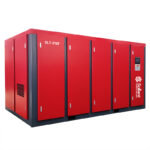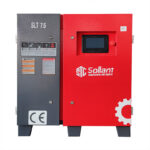Air compressors are essential for industrial operations, and when they have been idle for a long period, they require a thorough inspection and preparation before restarting. This ensures safe, stable, and efficient operation, preventing potential failures due to prolonged inactivity.
This guide outlines the critical inspections and preparatory steps needed before restarting an air compressor that has been shut down for an extended period.
1. Appearance Inspection
Before starting any mechanical or electrical checks, visually inspect the air compressor to identify any visible issues.
✅ 1.1 Clean the Equipment Surface
- Remove accumulated dust, grease, and debris.
- Ensure radiator fins, vents, and air passages are clear for proper heat dissipation.
✅ 1.2 Check Fasteners
- Inspect bolts, nuts, and connections for looseness.
- Pay special attention to:
- Base frame bolts
- Pipe fittings and joints
- Compressor mounting supports
- Tighten any loose fasteners to prevent vibrations during operation.
✅ 1.3 Inspect Electrical Cables and Wiring
- Check for damaged, aged, or loose power cables and control wiring.
- Ensure terminal connections are secure.
- Replace any worn-out or frayed wires to avoid electrical faults.
2. Lubrication System Inspection
Lubrication is crucial for smooth compressor operation. After a long shutdown, lubricant degradation or loss can lead to increased friction and wear.
✅ 2.1 Check Lubricant Level
- Verify that the oil level is within the recommended range.
- If the level is low, refill with the appropriate type of oil.
✅ 2.2 Replace Lubricating Oil
- If the compressor has been idle for more than six months, the oil may have degraded.
- Drain old oil, clean the oil system, and refill with fresh lubricant.
✅ 2.3 Inspect the Oil Filter
- Check for blockages or contamination in the oil filter.
- Replace the filter if necessary to maintain proper lubrication flow.
3. Cooling System Inspection
Proper cooling prevents overheating and efficiency losses.
✅ 3.1 Examine the Cooler
- Check for dust buildup or scale deposits on air-cooled or water-cooled systems.
- Clean the cooler to ensure efficient heat dissipation.
✅ 3.2 Inspect the Cooling Fan
- Verify that the fan blades are intact and spin freely.
- Check for unusual noise or resistance when rotating manually.
✅ 3.3 Check the Cooling Water System (For Water-Cooled Compressors)
- Ensure water pipes are clear and unobstructed.
- Inspect the water pump for normal operation.
- Confirm that the cooling water quality meets system requirements.
4. Air System Inspection
The air system must be free of obstructions and leaks for efficient compressor operation.
✅ 4.1 Inspect the Air Intake Filter
- Remove and clean the air filter.
- Replace the filter if it is clogged or damaged.
✅ 4.2 Check Pipelines and Valves
- Inspect the intake and exhaust pipelines for leaks, cracks, or obstructions.
- Check that valves operate smoothly and are not stuck or leaking.
✅ 4.3 Inspect the Air Receiver Tank
- Drain any water condensation accumulated inside the tank.
- Check for rust or corrosion and clean the interior if necessary.
5. Electrical System Inspection
A faulty electrical system can cause startup failures, short circuits, or motor damage.
✅ 5.1 Motor Insulation Test
- Use a megohmmeter to measure the insulation resistance of the motor windings.
- If the resistance is below the recommended value, dry the motor or replace it.
✅ 5.2 Check the Control Panel
- Ensure the controller, display, buttons, and indicators are functioning properly.
- Check for burnt components or loose wiring.
✅ 5.3 Verify the Power Supply
- Confirm that the power voltage and frequency match the compressor’s specifications.
- Inspect the circuit breaker and safety switches for proper function.
6. Preparations Before Trial Operation
Before fully restarting the air compressor, perform gradual checks to ensure smooth operation.
✅ 6.1 Manual Cranking
- Rotate the compressor shaft manually to check for:
- Smooth rotation
- No mechanical resistance
- No abnormal noises
- This helps detect possible internal blockages or seizing before applying power.
✅ 6.2 Inching Trial Run
- Perform a short, low-power test run to observe:
- Startup response
- Vibration levels
- Unusual noises or overheating
- If the compressor runs smoothly, proceed to normal startup.
✅ 6.3 Gradual Loading
- Start the air compressor with no load initially.
- Slowly increase the load in steps to avoid mechanical stress or electrical surges.
7. Important Precautions
⚠ 7.1 Follow Operating Procedures
- Always adhere to the manufacturer’s startup guidelines.
- Avoid skipping safety steps to prevent damage or injury.
⚠ 7.2 Maintain Regular Inspections
- Even during long shutdown periods, conduct routine checks to prevent component deterioration.
⚠ 7.3 Keep Detailed Inspection Records
- Log all inspection findings, replacements, and adjustments.
- Helps in tracking compressor performance and identifying recurring issues.
8. Conclusion
Restarting an air compressor after a long shutdown requires careful inspection and preparation to avoid equipment failures and ensure safe operation.
By systematically checking the mechanical, electrical, lubrication, cooling, and air systems, potential risks can be mitigated, leading to reliable and efficient performance.
Following these best practices will help you: ✔ Avoid sudden failures during startup
✔ Extend the compressor’s lifespan
✔ Ensure consistent and efficient operation
🔧 Be proactive—conduct thorough inspections before restarting your air compressor to ensure smooth and trouble-free operation! 🚀


